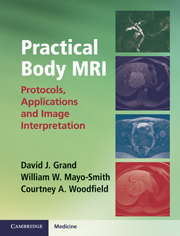Book contents
- Frontmatter
- Contents
- Preface
- To the reader
- Acknowledgments
- Glossary of terms andabbreviations used in Body MRI
- Section 1 Body MRI overview
- Section 2 Abdomen
- Section 3 Pelvis
- Section 4 MRI angiography
- Chapter 14 MRA introduction
- Chapter 15 Chest MRA
- Chapter 16 Abdomen-pelvis MRA
- Chapter 17 Body MRV
- Index
- References
Chapter 17 - Body MRV
from Section 4 - MRI angiography
Published online by Cambridge University Press: 05 November 2012
- Frontmatter
- Contents
- Preface
- To the reader
- Acknowledgments
- Glossary of terms andabbreviations used in Body MRI
- Section 1 Body MRI overview
- Section 2 Abdomen
- Section 3 Pelvis
- Section 4 MRI angiography
- Chapter 14 MRA introduction
- Chapter 15 Chest MRA
- Chapter 16 Abdomen-pelvis MRA
- Chapter 17 Body MRV
- Index
- References
Summary
Pelvic MRV protocol
Indications
This protocol is used for evaluating venous flow through the pelvis.
Preparation
IV contrast agent: 1 mmol/kg gadopentetate dimeglumine at 2 cc/s
Oral contrast agent: None
No IV contrast if the patient is pregnant
Utilize a superior saturation pulse to saturate arterial flow
Cover from above aortic bifurcation (approximately L3) through iliacs
If flow is absent on one or both sides, add repeat axial SSFP in the decubitus position with the affected side up. This is done to determine if the void is due to a compression rather than a blockage.
Exam sequences andwhatwe are looking for
(1) Coronal T2 single-shot fast-spin echo – Evaluate coil placement.
(2) Axial 2D time of flight (TOF) – Cover from aorta bifurcation (approx. L3) through iliacs. Evaluate for filling defects within pelvic veins.
(3) Axial SSFP – Cover from aorta bifurcation (approx. L3) through iliacs. Evaluate for filling defects within pelvic veins.
(4) Coronal SSFP – Evaluate for filling defects within pelvic veins.
(5) Axial T1-weighted volume-interpolated gradient echo BH pre.
(6) Axial T1-weighted volume-interpolated gradient echo BH post IV administration of contrast at 2 minutes.
- Type
- Chapter
- Information
- Practical Body MRIProtocols, Applications and Image Interpretation, pp. 152 - 153Publisher: Cambridge University PressPrint publication year: 2012



